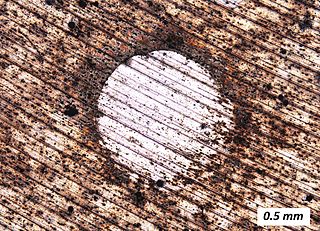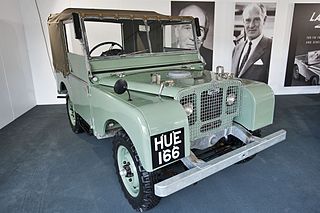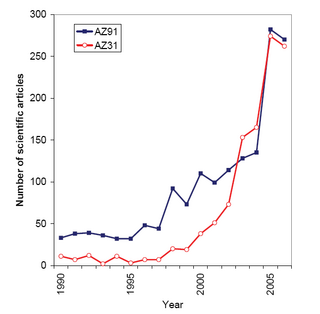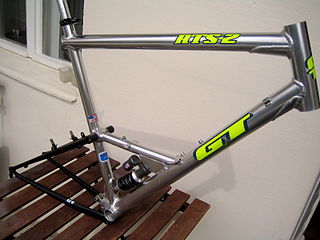
Duralumin is a trade name for one of the earliest types of age-hardenable aluminium alloys. The term is a combination of Dürener and aluminium.
Cupronickel or copper-nickel (CuNi) is an alloy of copper that contains nickel and strengthening elements, such as iron and manganese. The copper content typically varies from 60 to 90 percent.

Monel is a group of alloys of nickel and copper, with small amounts of iron, manganese, carbon, and silicon. Monel is not a cupronickel alloy because it has less than 60% copper.

Birmabright is a trade name of the former Birmetals Co. for various types of lightweight sheet metal in an alloy of aluminium and magnesium. The alloy was introduced by the Birmid Group in 1929 and was particularly noted for its corrosion resistance. Birmal Boats was created in 1930 for the building of light-alloy boats. Birmetals Ltd was formed in 1936 and during the war produced both copper bearing aluminium alloys and the Birmabright magnesium bearing alloys, mainly for aircraft production.

Aluminium bronze is a type of bronze in which aluminium is the main alloying metal added to copper, in contrast to standard bronze or brass. A variety of aluminium bronzes of differing compositions have found industrial use, with most ranging from 5% to 11% aluminium by weight, the remaining mass being copper; other alloying agents such as iron, nickel, manganese, and silicon are also sometimes added to aluminium bronzes.

Magnesium alloys are mixtures of magnesium with other metals, often aluminium, zinc, manganese, silicon, copper, rare earths and zirconium. Magnesium alloys have a hexagonal lattice structure, which affects the fundamental properties of these alloys. Plastic deformation of the hexagonal lattice is more complicated than in cubic latticed metals like aluminium, copper and steel; therefore, magnesium alloys are typically used as cast alloys, but research of wrought alloys has been more extensive since 2003. Cast magnesium alloys are used for many components of modern automobiles and have been used in some high-performance vehicles; die-cast magnesium is also used for camera bodies and components in lenses.
Magnalium is an aluminium alloy with 5% magnesium and 95% aluminum.

An aluminium alloy is an alloy in which aluminium (Al) is the predominant metal. The typical alloying elements are copper, magnesium, manganese, silicon, tin, nickel and zinc. There are two principal classifications, namely casting alloys and wrought alloys, both of which are further subdivided into the categories heat-treatable and non-heat-treatable. About 85% of aluminium is used for wrought products, for example rolled plate, foils and extrusions. Cast aluminium alloys yield cost-effective products due to the low melting point, although they generally have lower tensile strengths than wrought alloys. The most important cast aluminium alloy system is Al–Si, where the high levels of silicon (4–13%) contribute to give good casting characteristics. Aluminium alloys are widely used in engineering structures and components where light weight or corrosion resistance is required.
7075 aluminium alloy (AA7075) is an aluminium alloy with zinc as the primary alloying element. It has excellent mechanical properties and exhibits good ductility, high strength, toughness, and good resistance to fatigue. It is more susceptible to embrittlement than many other aluminium alloys because of microsegregation, but has significantly better corrosion resistance than the alloys from the 2000 series. It is one of the most commonly used aluminium alloys for highly stressed structural applications and has been extensively used in aircraft structural parts.

Alclad is a corrosion-resistant aluminium sheet formed from high-purity aluminium surface layers metallurgically bonded to high-strength aluminium alloy core material. It has a melting point of about 500 degrees celsius, or 932 degrees Fahrenheit. Alclad is a trademark of Alcoa but the term is also used generically.

In the automotive industry, alloy wheels are wheels that are made from an alloy of aluminium or magnesium. Alloys are mixtures of a metal and other elements. They generally provide greater strength over pure metals, which are usually much softer and more ductile. Alloys of aluminium or magnesium are typically lighter for the same strength, provide better heat conduction, and often produce improved cosmetic appearance over steel wheels. Although steel, the most common material used in wheel production, is an alloy of iron and carbon, the term "alloy wheel" is usually reserved for wheels made from nonferrous alloys.
5083 aluminium alloy is an aluminium alloy with magnesium and traces of manganese and chromium. It is highly resistant to attack by seawater and industrial chemicals.
5005 aluminium alloy is an aluminium alloy with good resistance to atmospheric corrosion. It is used in decorative and architectural applications.
5052 is an aluminium alloy, primarily alloyed with magnesium and chromium.
1050 aluminium alloy is an aluminium-based alloy in the "commercially pure" wrought family. As a wrought alloy, it is not used in castings. Instead, it is usually formed by extrusion or rolling. It is commonly used in the electrical and chemical industries, on account of having high electrical conductivity, corrosion resistance, and workability. 1050 alloy is also sometimes used for the manufacture of heat sinks, since it has a higher thermal conductivity than other alloys. It has low mechanical strength compared to more significantly alloyed metals. It can be strengthened by cold working, but not by heat treatment.
2219 aluminium alloy is an alloy in the wrought aluminium-copper family. It can be heat-treated to produce tempers with higher strength but lower ductility. The aluminium-copper alloys have high strength, but are generally less corrosion resistant and harder to weld than other types of aluminium alloys. To compensate for the lower corrosion resistance, 2219 aluminium can be clad in a commercially pure alloy such as 1050 or painted. This alloy is commonly formed by both extrusion and forging, but is not used in casting.
3004 aluminium alloy is an alloy in the wrought aluminium-manganese family. It is similar to the 3003 alloy, except for the addition of approximately 1% magnesium. It can be cold worked to produce tempers with a higher strength but a lower ductility. Like most other aluminium-manganese alloys, 3003 is a general-purpose alloy with moderate strength, good workability, and good corrosion resistance. It is commonly rolled and extruded, but typically not forged. As a wrought alloy, it is not used in casting.
5456 aluminium alloy is an alloy in the wrought aluminium-magnesium family. While it is closely related to 5356 aluminium alloy, it is used in structural applications, like most other aluminium-magnesium alloys, and not as filler for welding. As a wrought alloy, it can be formed by rolling, extrusion, and forging, but not casting. It can be cold worked to produce tempers with a higher strength but a lower ductility. It is susceptible to exfoliation corrosion when held at temperatures above 65 °C (150 °F) for extended periods of time.
2218 aluminium alloy is an alloy in the wrought aluminium-copper family. It is one of the most complex grades in the 2000 series, with at least 88.4% aluminium by weight. Unlike most other aluminium-copper alloys, 2218 is a high work-ability alloy, with relatively low for 2xxx series alloy yield strength of 255 MPa. Despite being highly alloyed, it have a good corrosion and oxidation resistance due sacrificial anode formed by magnesium inclusions, similar to marine-grade 5xxx series alloys. Although 2218 is wrought alloy, owing to granular structure it can be used in casting and been precisely machined after casting. It is easy to weld, coat, or glue.








